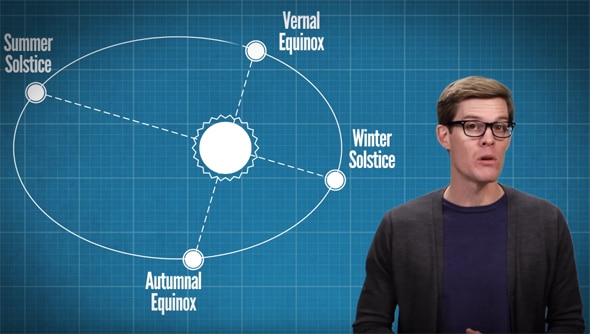Create a free profile to get unlimited access to exclusive videos, sweepstakes, and more!
Happy Vernal Equinox 2016! But What Does That Mean?

Saturday is the vernal equinox! Well, Saturday night is, depending on where on Earth you are. The moment happens at 04:30 UTC on March 20 this year, which is, for example, March 19 at 10:30 p.m. Mountain (U.S.) time where I live.
But what does that mean, exactly? Why, let my friend Joe Hanson explain it to you in an episode of “It’s Okay to Be Smart”:
The equilux point he makes is a good one. It’s even worse than he describes; our atmosphere scatters sunlight, spreading it out. That’s why we have twilight; the air is lit up even when the Sun is well below the horizon. There are different definitions for twilight depending on what you mean by it, but a fair one is when the center of the Sun is about 12° below the horizon. The Sun moves across the sky at about a degree every four minutes*, so twilight is bright for very roughly a half hour before sunrise and after sunset.
So equilux can be hard to define if you dive into the details about it.
One thing I always notice this time of year, too, is that the Sun seems to set noticeably farther north every day. At the December solstice it’s as far south as it can be on the horizon for Northern Hemisphere observers. At the June solstice it’s as far north as it gets. At the equinoxes it sets due west.
But the rate at which the sunset point moves north from winter to summer changes. It’s very slow at first, then speeds up to a maximum at the equinox, then slows again. So right now, not only is it setting farther north every day, but the amount it moves north every day is largest. Starting after the equinox it begins to slow, and stops at the solstice (which literally means “the Sun stands still”).
If you’re mathematically inclined, the point on the horizon where the Sun sets is like a sine wave, moving south to north and back again with a period of one year. The speed at which that point moves along the horizon is the derivative of that, which is a cosine curve. Call due west on the horizon 0°, north +90°, and so on. When the Sun sets due west, on the equinox, the sine value is 0, but the cosine is maximized. That means the change in the position where the Sun sets is moving at its fastest speed. At the solstices the sine is maximized (the actual value depends on the Earth’s tilt and your latitude), but the absolute value of the cosine is minimized at 0, and then the cosine switches sign. In other words, the sunset point slows to a stop and then reverses direction the next day.
This gets worse because the Earth’s orbit is an ellipse, which messes with things, as Joe pointed out in his video. But it’s close enough. People make analemma photos all the time, showing the Sun’s position in the sky over the course of a year. I’d love to see the same thing, but instead showing the Sun just at sunset every day of the year. Then this speeding up and slowing of the Sun’s sunset point would be obvious. That’d be quite an effort, though, and I’ve never seen one made. Any takers?
*Correction, March 19, 2016, at 17:15 UTC: I originally wrote the Sun moves a degree every two minutes. I meant to write it moves through its own diameter, 1/2 a degree, every two minutes. Anyway, the correction should be more clear.


























